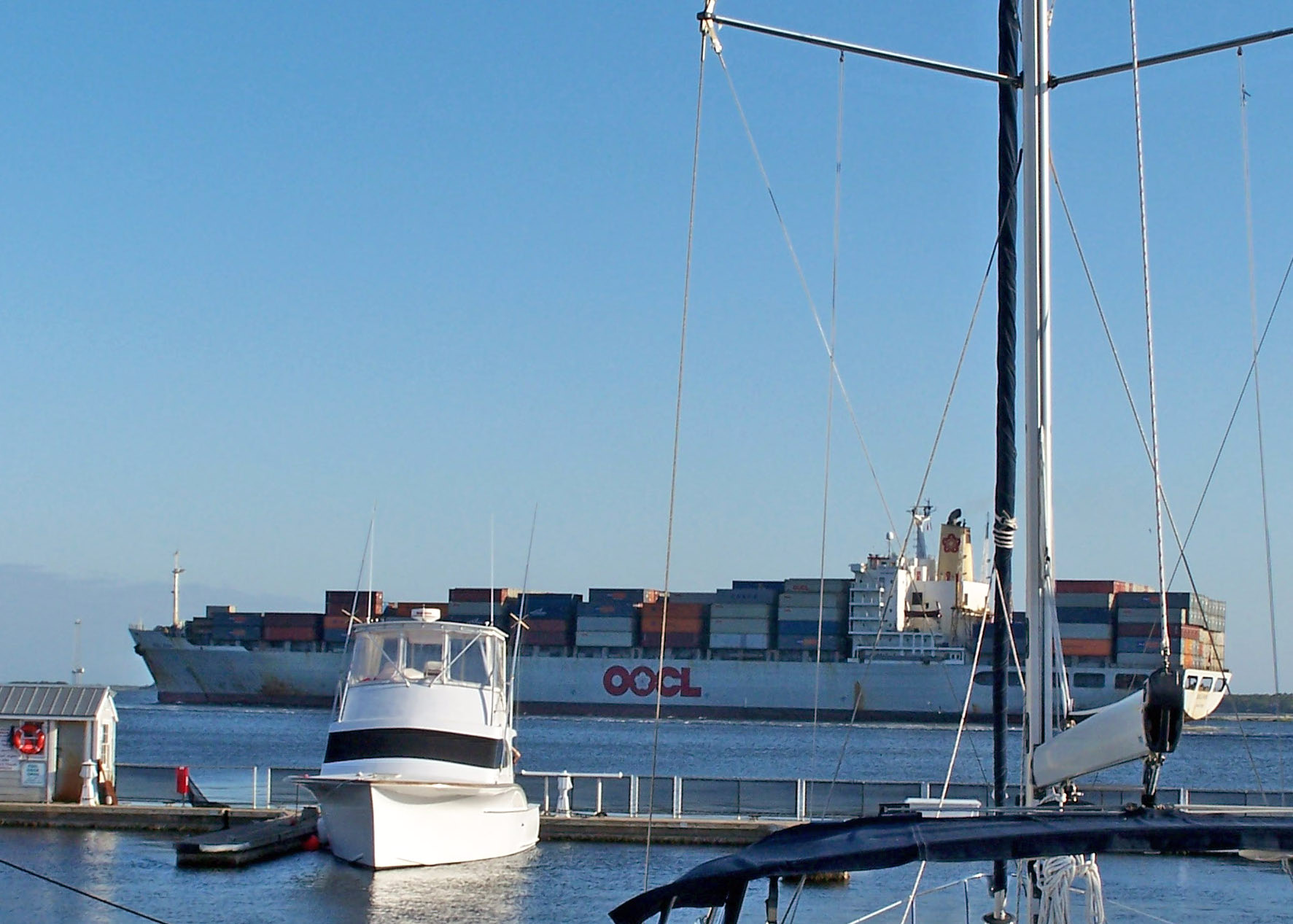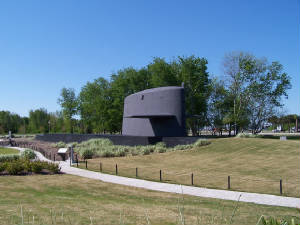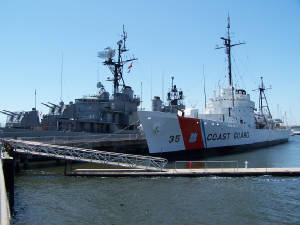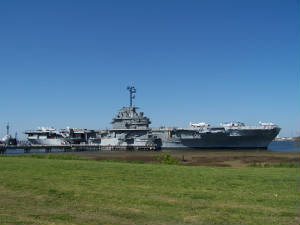Saturday, April 16, 2005 Beaufort to Charleston
Harbor
72.8 miles (a new one-day record for us)
As predicted, we woke to 20-25 mph winds and a temperature in the mid-40s. Yesterday, the same high
winds kept us in port, but we decided today to push ourselves beyond our comfort zone and make a run for it.
The first challenge (and, as it turned out, the only significant one of the day) was getting off
the dock. The wind was directly to the side of the boat, pushing us against the dock. We had other boats directly
in front and in back of us, like close parallel parking. We didn't have much maneuvering room.
By running a line from the stern of the boat forward and tying it to the dock, then running one engine in
reverse, the bow of the boat could be pivoted away from the dock. At least that's the theory. We did manage to
accomplish this maneuver after several tries, with an ever increasing number of helpers and bystanders on the dock, including
the owner of the sailboat in front of us, who became increasingly agitated throughout our extended efforts, especially
when our anchor hooked on the flagstaff of his boat. We did finally mange to get off the dock with no damage done, shouting
our thank yous to the crowd as we pulled away.
Like so many of our adventures aboard Starsong, we learned a lot from the experience, and think we can do
it better next time. However, part of the learning was that sometimes the wind is strong enough to pin you to the dock
until it subsides, and there's no point in even trying to fight it.
Our run up to Charleston Harbor was windy, but uneventful. We passed through some wide water, but
none where the waves had built up to any substantial size. The winds were strong and cool, but we kept our flybridge
enclosed and it wasn't uncomfortable.
We arrived in Charleston Harbor at about 3:30 and took a minor detour up near
Fort Sumter to avoid a stretch of the harbor marked "restricted area" on our charts. Our calls to the marina to
clarify whether we could traverse this stretch were singularly unhelpful. No matter, the detour gave us a chance to
get a photo of the fort in great light and clear weather.

|
| Fort Sumter |
We'll take a moment to digress with a little history lesson about Fort Sumter. When we were in Beaufort,
we saw the house where the articles of seccession were drafted, a critical step leading to the Civil War, or, as they like
to call it down South, the War Between the States. The second spot in South Carolina that played a critical role in
kicking off the war was Fort Sumter.
When South Carolina secceded, there were four Federal forts around Charleston Harbor. Within six
days, the commander of the only fort with more than a nominal number of men garrisoned there decided his fort was indefensible
and transferred his men to Fort Sumter. The state and the U.S. government tussled over the harbor, with the state
demanding that the Federal government evacuate the fort and harbor, and the Federal government not only refusing, but
attempting to send in men and provisions. They debated for months -- no shots were fired.
One month after President Lincoln assumed office, he sent a relief mission of merchant ships protected by
war ships. The Confederates, informed in advance of this action, demanded that the commander of the fort, Major
Robert Anderson, surrender Sumter. They sent their ultimatum at 3:20 am, and gave him a one hour deadline.
At ten minutes after the deadline hour, Confederate Captain George James ordered the firing of a signal shell. Within
moments, the first gunfire of the war was touched off, and by daybreak all three Confederate forts on the harbor
were firing on Sumter.
Anderson agreed to a truce by 2 that afternoon, and he surrendered that evening. In the first battle of the war, the Union troops were defeated, and Fort Sumter reverted to Confederate control, where
it remained until finally on February 17, 1865, it was evacuated in advance of General Sherman's northward march from Savannah.
By that time, the fort had withstood so much battering that it hardly resembled a fort at all, with big sections reduced to
piles of rubble.
Now it's a national monument run by the National Park Service.
On our two previous cruises to Charleston Harbor, we stayed at the City Marina, conveniently located near
the historic district of Charleston. This time, we decided to stay on the other side of the harbor, at Charleston Harbor Marina.
The marina is located adjacent to the Patriot's Point Naval and Maritime Museum, so we were docked in the shadow
of its massive warship and aircraft carrier. As if that weren't enough big ship exposure, the marina is also
close to the large ship lanes that run through the harbor, so we had spectacular views of container ships as we sat
relaxing on our flybridge. We counted 500 containers (the size of a semi-trailer) on one ship.

|
| Container ship passing--view from our docked boat |
By the time we docked at a little after 4:30, we had put on over eight hours of travel time in less than
pleasant weather. We were whupped, but Starsong was encrusted with salt from our passage, so Dick took about
15 minutes to relax, then was out giving her a thorough washing. Nearly two hours later, he was done.
We decided to just eat at the Hilton Hotel that anchors the complex where the marina is located. We waded
through a wedding party out on the patio, and ate in the elegant white tablecloth restaurant wearing our grungy boat
clothes. For most of the meal, we had the place to ourselves.
We didn't last too long after dinner. We called it a night early, anticipating a busy day of exploring on
Sunday.
Sunday, April 17, 2005 Patriot Point and Mount Pleasant, SC
Starbucks was less than a two-mile bike ride away, so we began the day with one of our favorite Sunday
rituals--consuming lattes and pastries while reading the New York Times.
Next, we picked off a geocache along a nature trail on our way to the Patriots Point Naval and Maritime
Museum.

|
| Cold War Submarine Memorial |
Before visiting the exhibits you have to pay to see, we stopped at the Cold War Submarine Memorial in a
park in front of the Museum. The Memorial is a wall with sections from a decommissioned submarine added, and landscaping
created to symbolize the bow wave (via a grassy mound) and the frothy side wakes (via ornamental grasses).
The Cold War, by this memorial's reckoning, lasted from March 12, 1947, when the Truman Doctrine was signed,
until November 9, 1989, when the Berlin Wall fell.
Reading the text plaques around the Memorial, we learned that in the initial years of the Cold War, there
were 41 nuclear submarines, all with ballistic missiles assembled and loaded in Charleston. The "41 for Freedom" each
carried more firepower than was expended by all the forces fighting World War II. That was a sobering thought.
On to the Maritime Museum, where we spent the next four and a half hours, but only saw a little more
than half the exhibits.
First we boarded Clagamore, a diesel-powered submarine with a crew of 80, in service from 1945 until 1975.
Everything about Clagamore (named after the tropical Blue Parrotfish we have seen while snorkeling Caribbean waters) was cramped
and clalstrophobic to the extreme. It was hard to imagine 20 men living aboard, let alone 80. A goodly portion
of the crew bunked among the torpedoes--gain a torpedo, lose a bunk.

|
| Laffey, behind the Coast Guard Cutter |
Next we boarded the Destroyer Laffey, in service 1944-75. Laffey saw action in World War I, Korea,
and atomic bomb tests in Bikini. Yesterday was the sixty-year anniversary of the day in 1945 when 22 Japanese bombers
and kamikazes attacked her within 80 minutes. Five kamikazes and three bombs hit her, and two near-misses caused additional
damage, killing 32 and wounding 71 of the 336-man crew. The crew shot down eleven planes and kept their ship afloat.
Later, Laffey would participate in the longest ship to shore battle of the Korean War.
Because of the anniversary, an annual volunteer work party of ship alumni was in progress, with lots of
veterans happy to interrupt their labors to answer questions.

|
| Marina view from Laffey deck |
Our last stop was the aircraft carrier USS Yorktown. A starker contrast to Clagamore
couldn't be found. Yorktown carried a drew of 380 officers and 3,088 enlisted men, and every aspect of her size and
operations awed by its immensity, although we were sure that the men piloting the jets landing on her flight deck found it
none too big.
The ship was so immense we found it hard to wrap our minds around it. One thing we do understand is
cooking. How do you cook three meals a day for over 3,000 men? You can get an idea from the ship's recipe for
chocolate chip cookies. It begins: 112 pounds chocolate chips, 165 pounds flour, 500 eggs (imagine cracking 500
eggs!), 100 pounds granulated sugar . . . All that, and it only makes enough to serve the crew three cookies apiece!

|
| U.S.S. Yorktown |
We toured the living quarters of both enlisted men and officers, medical and dental offices and labs, engine
rooms, radar rooms, the kitchens (of course), displays of planes on the flight deck, lots of nooks and crannies throughout
the ship. It was far more interesting than I expected it to be, maybe because now we are living aboard, too, albeit
on a scale that is microscopic by comparison.
Our day wasn't over yet. We hopped on our bikes and rode a few miles to Shem Creek, an area where
the fishing boats dock and people congregate at lively dockside restaurants. We found the fish store recommended by
the Hilton concierge, bought a pound of fresh jumbo shrimp, had them pack it in ice, took the bridge over Shem Creek, and
rode around exploring the beautiful little town of Mount Pleasant. The town is a wonderful mix of modest cottages and
impressive waterfront estates, all beautifully landscaped and lovingly maintained. We stopped to read historic plaques
as we went, and there were many.
Finally, as the sun was getting low, we headed back to the boat to prepare Shrimp Scampi and finally put
our feet up for a few moments of relaxation before bedtime.
To continue North in South Carolina, visiting Georgetown and Barefoot Landing, click here.
|

